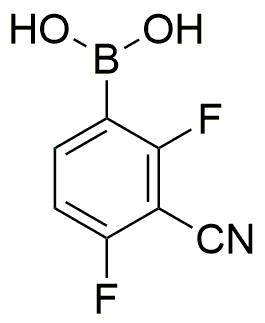3-Cyano-2,4-difluorophenylboronic acid is widely utilized in research focused on:
- Pharmaceutical Development: This compound serves as a key intermediate in the synthesis of various pharmaceuticals, particularly in the development of anti-cancer agents, due to its ability to form stable complexes with biological targets.
- Organic Synthesis: It is employed in cross-coupling reactions, such as Suzuki-Miyaura coupling, which are essential for constructing complex organic molecules, making it valuable in the production of agrochemicals and fine chemicals.
- Material Science: The compound is used in the development of advanced materials, including polymers and nanomaterials, enhancing properties like conductivity and strength, which are crucial for electronics and coatings.
- Bioconjugation: Its boronic acid functionality allows for selective binding to diols, making it useful in bioconjugation techniques for labeling biomolecules, aiding in drug delivery systems and diagnostic applications.
- Research in Chemical Biology: This compound is utilized in probing biological systems and pathways, providing insights into disease mechanisms and potential therapeutic targets, which is essential for advancing medical research.
General Information
Properties
Safety and Regulations
Applications
3-Cyano-2,4-difluorophenylboronic acid is widely utilized in research focused on:
- Pharmaceutical Development: This compound serves as a key intermediate in the synthesis of various pharmaceuticals, particularly in the development of anti-cancer agents, due to its ability to form stable complexes with biological targets.
- Organic Synthesis: It is employed in cross-coupling reactions, such as Suzuki-Miyaura coupling, which are essential for constructing complex organic molecules, making it valuable in the production of agrochemicals and fine chemicals.
- Material Science: The compound is used in the development of advanced materials, including polymers and nanomaterials, enhancing properties like conductivity and strength, which are crucial for electronics and coatings.
- Bioconjugation: Its boronic acid functionality allows for selective binding to diols, making it useful in bioconjugation techniques for labeling biomolecules, aiding in drug delivery systems and diagnostic applications.
- Research in Chemical Biology: This compound is utilized in probing biological systems and pathways, providing insights into disease mechanisms and potential therapeutic targets, which is essential for advancing medical research.
Documents
Safety Data Sheets (SDS)
The SDS provides comprehensive safety information on handling, storage, and disposal of the product.
Product Specification (PS)
The PS provides a comprehensive breakdown of the product’s properties, including chemical composition, physical state, purity, and storage requirements. It also details acceptable quality ranges and the product's intended applications.
Certificates of Analysis (COA)
Search for Certificates of Analysis (COA) by entering the products Lot Number. Lot and Batch Numbers can be found on a product’s label following the words ‘Lot’ or ‘Batch’.
*Catalog Number
*Lot Number
Certificates Of Origin (COO)
This COO confirms the country where the product was manufactured, and also details the materials and components used in it and whether it is derived from natural, synthetic, or other specific sources. This certificate may be required for customs, trade, and regulatory compliance.
*Catalog Number
*Lot Number
Safety Data Sheets (SDS)
The SDS provides comprehensive safety information on handling, storage, and disposal of the product.
DownloadProduct Specification (PS)
The PS provides a comprehensive breakdown of the product’s properties, including chemical composition, physical state, purity, and storage requirements. It also details acceptable quality ranges and the product's intended applications.
DownloadCertificates of Analysis (COA)
Search for Certificates of Analysis (COA) by entering the products Lot Number. Lot and Batch Numbers can be found on a product’s label following the words ‘Lot’ or ‘Batch’.
*Catalog Number
*Lot Number
Certificates Of Origin (COO)
This COO confirms the country where the product was manufactured, and also details the materials and components used in it and whether it is derived from natural, synthetic, or other specific sources. This certificate may be required for customs, trade, and regulatory compliance.


